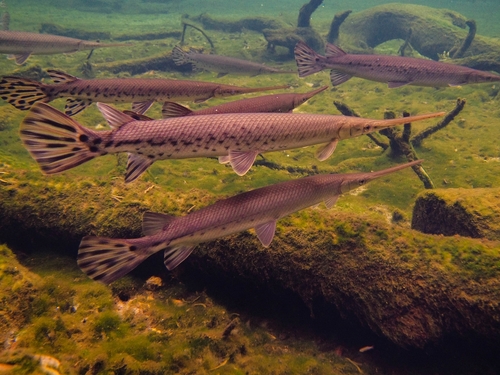
Longnose Gar
The Atlantic Bluefin Tuna (Thunnus thynnus) is a majestic and powerful fish, renowned for its size, speed, and commercial value. This highly migratory species plays a crucial role in the marine ecosystem.
15 36 years
Lifespan
90 - 150 cm
Length
Least Concern
Conservation Status
5 km/h
Swimming speed
Carnivorous
Diet
Local Migration
Migration
Appearance Overview
The Atlantic Bluefin Tuna is renowned for its large, streamlined body, built for speed and endurance.
Color
Dark metallic blue above, silvery white below
Body shape
Torpedo-shaped, with a robust and streamlined body
Fins
Two dorsal fins, the first depressible; short pectoral fins
Other
Possesses a unique network of blood vessels that maintains a body temperature higher than the surrounding water
Length
Up to 13 feet (4 meters)
Weight
Up to 2,000 lbs (900 kg)
Diet
Carnivorous, feeding on a variety of fish, squid, crustaceans, and eels.
Feeding Behavior
Highly active predator, known for its speed and agility. Often hunts cooperatively, herding and trapping prey.
Social Behavior
Forms large schools, especially during spawning season. Known for long-distance migrations.
Commercial Relevance
Extremely high value, particularly in the sushi and sashimi markets, where its fatty flesh is considered a delicacy.
Conservation measures
Subject to strict fishing quotas, international agreements, and monitoring programs. Some aquaculture efforts are underway.
Status
Endangered
Threats
Overfishing (historically and ongoing), illegal fishing, bycatch in other fisheries, climate change affecting prey distribution.
Habitat Distribution
Depth Range
0-1,000 meters (typically in surface waters, but can dive deep)
Geographic Range
Atlantic Ocean, Mediterranean Sea, and formerly the Black Sea
Preferred Environment
Temperate and subtropical waters; pelagic (open ocean)
Reproduction and Life Cycle
Breeding Habits
Spawns in warm waters, primarily in the Mediterranean Sea and the Gulf of Mexico. Spawning occurs in large aggregations.
Development Stages
Eggs hatch into larvae, which develop rapidly. Juveniles grow quickly, reaching significant size within their first year.
Fecundity
Females can release up to 30 million eggs per spawning season.
Maturity Age
Reaches sexual maturity at around 4-8 years, depending on the population.
Faqs about Longnose Gar
How long do Atlantic Bluefin Tuna live?
They can live up to 40 years, although this is becoming increasingly rare due to fishing pressure.
How fast can they swim?
They are among the fastest fish in the ocean, capable of bursts of speed up to 40-60 mph.
Are Bluefin Tuna warm-blooded?
They are warm-blooded, which allows them to maintain a higher body temperature than the surrounding water, aiding in muscle efficiency.
Do they migrate?
Yes, they undertake extensive migrations across the Atlantic Ocean for feeding and spawning.
Why are they endangered?
The high demand for sushi and sashimi, combined with slow maturation rates, has led to significant population declines.
Where do Atlantic Bluefin Tuna spawn?
They spawn in two main areas: the Mediterranean Sea and the Gulf of Mexico.
What do they eat?
Their diet includes a wide range of fish like herring and mackerel, as well as squid and crustaceans.
Is fishing for Bluefin Tuna regulated?
Yes, there are strict regulations, including quotas and size limits, managed by international organizations.
Can Bluefin Tuna be farmed?
While aquaculture is being explored, it is challenging due to their size, migratory nature, and dietary needs.
Where are Atlantic Bluefin Tuna found?
They are found in the Atlantic Ocean, from the eastern coast of North America to the Mediterranean Sea.
Copyright @ Nature Style Limited. All Rights Reserved.
 English
English